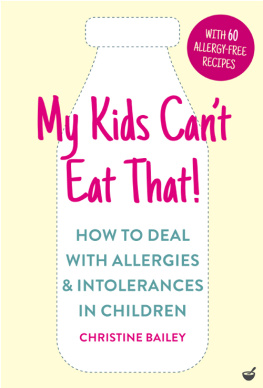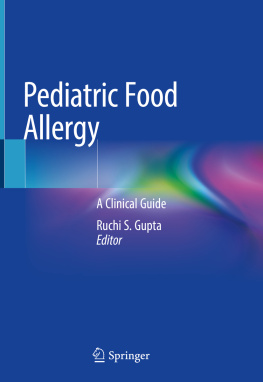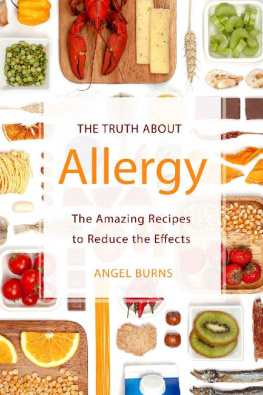Note: The information in this book is true and complete to the best of our knowledge. This book is intended only as an informative guide for those wishing to know more about health issues. In no way is this book intended to replace, countermand, or conflict with the advice given to you by your own physician. The ultimate decision concerning care should be made between you and your doctor. We strongly recommend you follow his or her advice. Information in this book is general and is offered with no guarantees on the part of the authors or Hachette Go. The authors and publisher disclaim all liability in connection with the use of this book.
Copyright 2021 by Ruchi Gupta, MD, MPH
Cover design by Terri Sirma
Cover photographs Science Photo Library/Getty; Science Photo Library/Shutterstock; Eggs, soybeans, avocado, shrimp/Shutterstock Cover copyright 2021 by Hachette Book Group, Inc.
Hachette Book Group supports the right to free expression and the value of copyright. The purpose of copyright is to encourage writers and artists to produce the creative works that enrich our culture.
The scanning, uploading, and distribution of this book without permission is a theft of the authors intellectual property. If you would like permission to use material from the book (other than for review purposes), please contact permissions@hbgusa.com. Thank you for your support of the authors rights.
Hachette Go, an imprint of Hachette Books
Hachette Book Group
1290 Avenue of the Americas
New York, NY 10104
HachetteGo.com
Facebook.com/HachetteGo
Instagram.com/HachetteGo
First Edition: August 2021
Hachette Books is a division of Hachette Book Group, Inc.
The Hachette Go and Hachette Books name and logos are trademarks of Hachette Book Group, Inc.
The publisher is not responsible for websites (or their content) that are not owned by the publisher.
Library of Congress Cataloging-in-Publication Data has been applied for.
ISBNs: 978-0-306-84650-2 (hardcover); 978-0-306-84649-6 (ebook)
E3-20210709-JV-NF-ORI
To the fearless individuals and families in my daily work who inspire me, and to my devout team who turns those inspirations into reality.
M Y PHONE RANG OFF THE HOOK. I T WAS THE BEGINNING OF 2019 AND mainstream media had just reported that more than 10 percent of adults in the USover 26 million peopleare estimated to have food allergy, and almost twice as many individuals52 millionbelieve they have food allergy but may have another food-related condition. Up to 85 million are avoiding certain foods due to food conditions. They use the term food allergy very loosely for many conditions that are not considered to be allergies in the medical community. And the words sensitivity and intolerance further cause confusion.
It was my research that produced these new surprising numbers, and everyone wanted to know whyhow is this possible? Wheres the smoking gun? The other shocker my epidemiological sleuthing found is that nearly half of adults with food allergy developed the condition during adulthood, which went patently against conventional wisdom that said allergies start in childhood. More questions came flooding in: Whats going on? How can we suddenly have so many challenges with food when not much has changed in our lifestyles and relationship with food? Or has it? What is to blame? Where is the source? And what explains foods unexpected turn on a grown adult (who likely has been eating the now troublesome food for decades)?
Indeed, I had my work cut out for me, alongside the many other curious doctors and researchers around the world. This was my opportunity to change the stereotypes around food allergy and get to the bottom of this growing epidemic. Luckily, these findings have coalesced with remarkable new therapies and technologies in medicine to identify, treat, and manage all kinds of food-related issues. At the same time, were rapidly learning how best to prevent allergic diseases and their relatives altogether.
Admittedly, unraveling the mysteries of food allergies was not always my passion or mission. Early in my career, my research focused primarily on asthma until I met a family in 2004 with two young children struggling with food allergies. It was an eye-opening and empowering experience for me. At that time, little did I know that as I dove into this largely uncharted territory, my work would so profoundly overlap with my personal life.
One day in the spring of 2006, my son was playing with my daughter, in between munching on a peanut butter and jelly sandwich. He was five and she was one. With his sticky fingers, he must have unknowingly touched her mouth and face. She soon broke out into hives on her face spreading down her neck and body, followed by vomiting. That was my first introduction to food allergies from a caregivers perspective. It was both shocking and terrifying. That day changed myand my daughterslife forever. From that moment on, food allergy management and research became a 24-7 job for me. I live it every dayI see patients with it, I conduct studies on it, I debunk myths about it to the young and old, and I come home to it.
Anyone who has or knows someone with food allergies or a food-related condition sees the world differently. Life suddenly becomes a minefield of potential hazards. You dont know where the next chance encounter with a problematic ingredient will come from, how bad the reaction will be, and whether it will involve (another) trip to the bathroom, pharmacy, or emergency room. Food is everywhere and encompasses so much in our culturefrom how we nourish ourselves daily just to survive, to how we celebrate special milestones and holidays throughout the year. We enjoy the company of others over food; plan events, outings, and gatherings around food; and make it a central part of our very being and happiness. Eating is a part of life no one can avoid, so when food becomes something to fear, life takes on a whole new meaning where allaying or ending those fears is tantamount.
Even if a food is not supposed to have a certain allergic ingredient, theres always the risk of cross-contact or accidental exposurethat dollop of chocolate ice cream served from the same scoop used for pistachio and hazelnut ice cream. A kale chip dusted in cashew powder. An expansive buffet table with unsuspecting dishes prepared using sesame oil and seeds. The number of times I have been confused about the potential safety of a food, second-guessed a food label, watched an individuals palpable fear over food, and have been generally worried is, frankly, enough to drive anybody nuts (no pun intended).
I wrote this book amid the Covid-19 pandemic. During this stressful time, weve all had to be extra mindful and careful about what we touch, where we go, with whom we socialize, how far we stand from potential sources of contaminants, how we engage in public settings (especially bars and restaurants), and what air we breathe. When you think about it, such hypervigilance is not that new for people with food allergies. However, unlike during the Covid-19 crisis, people with food allergies may have their condition for life and will continue to live this way long after the pandemic. The food allergy epidemic is exceedingly complex, and the fact that diagnosing the various food-related conditions across the entire spectrum is neither straightforward nor foolproof further muddies the waters.
The spectrum! As my research into food allergies grows, it has become so evident that there is an ever-expanding list of conditions, many with unclear causes, that often get lumped into this terminology food allergy, although they may have a different mechanism of action in the body. In this book, we will refer to this myriad of food conditions as masqueradersother conditions that may cause symptoms after eating particular foods but do not include the biological (immune-based) reactions characteristic of food allergy (and are thus categorized differently in medicine).








